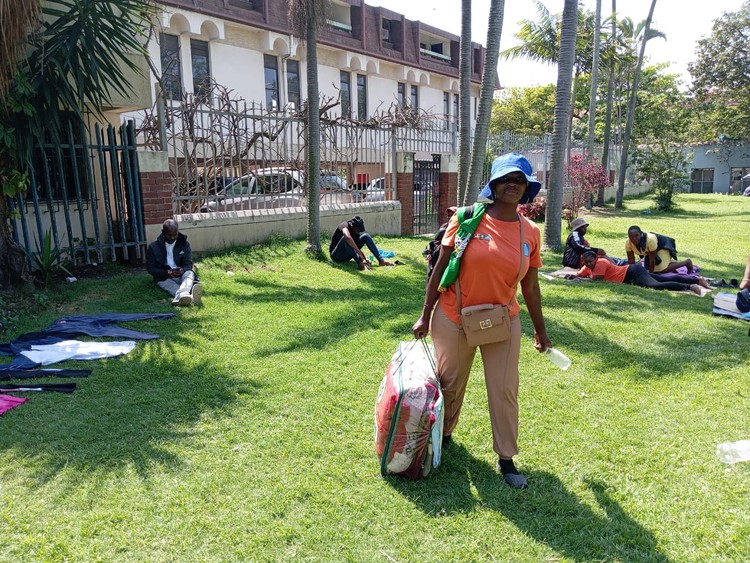This is the third and final part in a series about payouts to miners with silicosis and their families. Illustration: Lisa Nelson
Lebohang Molise* worked underground as a driller for 23 years, during which he nearly lost his leg in a rock fall, had a bone in his foot crushed, and developed TB and silicosis. He claimed compensation through the Q(h)ubeka Trust, set up after a court settlement between mineworkers and their former employers. But Molise died before the payout of more than R340,000 could be made. His story is told in the report of the Trust, which wound up in April this year after paying out more than R420-million in claims.
Lebogang Molise was born on 3 March 1949, in what was then the British Crown colony of Basutoland, high in the mountains in Quthing district. He began his first 12 month contract with The Employment Bureau of Africa (TEBA) at Libanon Gold Mine (part of the Gold Fields group, near Carletonville). By then Basutoland had gained its independence from the United Kingdom and had been renamed the Kingdom of Lesotho.
After six months back home, Molise switched to a new employer, Anglo American, and was sent to the Free State Saaiplaas gold mine near Welkom. He was to complete 23 year-long contracts at this one mine, working underground as a driller, over the next 31 years.
During this time, the mine changed its name twice, first to FreeGold, then Masimong gold mine, after Anglo sold it to Harmony in 1997. To start with, Molise took quite long breaks between contracts, sometimes more than a year.
He worked eight year-long contracts in the 14 years from 1970 to 1984. In 1981 he got married to Emily* in Quthing. In 1982, at the start of Molise’s eighth contract, the medical examiner at Free State Saaiplaas stated: “This worker has been clinically and radiologically examined and found free from Pneumoconiosis and Tuberculosis and fit for work in a dusty atmosphere.” The pace of work now picked up — he worked eight, year-long contracts in just nine years to 1994.
Molise had a wife and three children, but he had seven years of bad luck between 1989 and 1996.
Silicosis
At the start of his 13th contract in 1989 he was diagnosed with silicosis. This was confirmed by a benefit examination for the Medical Bureau for Occupational Diseases (MBOD) in mines and works at Ernest Oppenheimer Hospital, Welkom. The MBOD stamped his application to the Compensation Commissioner for Occupational Diseases in mines and works (CCOD) for a “Benefit by a Black Person” in terms of ODMWA – the Occupational Diseases in Mines and Works Act of 1973.
On 2 February 1989, the Chair of the MBOD’s Medical Certification Committee signed the finding: “TB – No; other compensatable diseases – Yes Pneumoconiosis”.
TEBA service documents do not show any change of job after this diagnosis.
In 2000, a hospital medical record card indicated that drugs were dispensed to Molise – the spindly scrawls did not show a reason. Notes here said that he had failed acclimatisation twice … ”chest pains, coughing, blood-stained sputum… Known silicosis has never been compensated.”
The TEBA records show that despite the silicosis diagnosis in 1989, Molise worked on as a driller for the next 14 years, in a hazardous environment with heat, noise and dust until 2003. By this time he was suffering from silicosis and tuberculosis “an occupational disease in the SECOND DEGREE …”.
Leg injury
But before then, there were two accidents underground. The first, on 28 August 1993, was very serious indeed. It occurred when part of the sidewall fell as he was drilling, trapping his right leg and tearing away the muscles. Over 300 pages of medical charts detailed ten days in the ICU, multiple blood transfusions, operations and several skin grafts as the skilled staff tried to save his leg. It was touch and go, he was often confused from the drugs and in pain, but he was discharged from hospital – on sick leave – after seven weeks. He returned to work, still drilling, on 23 February 1994 after 181 days off work.
Doctors reduced his permanent disablement percentage to 1% from a previous 15%, because the wounds had healed. He attended a disability assessment for compensation in terms of the Compensation for Occupational Injuries and Diseases Act (COIDA): “massive crush and avulsion muscles R thigh….20 cm scar healed”.
On 8 October 1996, Rand Mutual Assurance rejected the claim for compensation for disablement, because of the lack of clinical information. Rand Mutual, founded in 1894 to administer Worker’s Compensation Insurance benefits to injured miners, operates under licence from the Department of Labour, and provides benefits in accordance with COIDA.
Bone crushed
Two months later, on 16 December 1996, Molise was injured again in an underground accident when rock penetrated his boot and crushed a bone in his right foot. He continued drilling until a stretcher was found for him. He was in hospital for six days and in plaster for three weeks. He attended physiotherapy sessions at the Ernest Oppenheimer Hospital and resumed work after 25 days off.
In June 1997, he attended a disability assessment for COIDA compensation: “compound committed fracture right foot first metatarsal”. Rand Mutual issued a cheque in his favour for R1,009 – lump sum compensation under COIDA for 1% disablement from a fractured right foot.
Molise worked almost continuously from now on, completing six contracts of a year each in under seven years. In June 1998, beginning his 20th contract as a driller at Saaiplaas , he went to AngloGold Health Service Free State Region for a three-yearly medical examination at the Occupational Health Center. “Age 49, Height 178; weight 69”. Harmony Hospital Occupational Health issued an initial certificate of fitness in 1999, as Molise began his 21st contract at the mine – recently absorbed by Harmony and renamed Masimong. Molise said on the form he had never had treatment for tuberculosis and never had any operations or serious injuries or accidents. He had consulted a doctor in the previous five years—for a flu-like illness. Height 177; weight 71kg. A note on the form referred to his previous examination.
The mine knew of his previous silicosis diagnosis.
An undated mine history for Molise shows he did high dust work at Saaiplaas for 12 years, at Masimong for three years up till July 2000, and that he was still employed in high dust work at Masimong from August 2000.
In January 2001, an MBOD form shows Molise was still working as a driller. The form said he had not previously been compensated for a compensable disease. Lerato Molise was identified as his dependent. He attended a MBOD benefit examination at Harmony Mine Hospital. He was diagnosed with Pulmonary Tuberculosis and TB treatment started on 12 January.
He was notified on 17 January that he tested positive for TB. He was issued with a Harmony Hospital Tuberculosis Card. The card says that he had not previously had TB.
Compensation
On 27 July 2001, relying on the examination at Harmony earlier in the year, the CCOD issued a certificate that Molise was suffering from silicosis and tuberculosis “an occupational disease in the SECOND DEGREE. Maximum certification – you therefore no longer qualify for examinations. Concerning possible compensation the CCOD will send you forms to complete.”
TEBA recorded another annual contract at Masimong from 28 October 2001 to 28 October 2002. After a two month break, Molise returned for a new contract on 8 January 2003. But he was immediately “booked off” ‘SICK’ . He had silicosis and TB.
On 13 January 2003, Harmony issued an exit medical certificate for him. This says he worked in hazard/risk environments with dust, noise and heat exposure from 1982 to January 2003. His chest Xray result at this date was “Fibrosis and Silicosis”. Occupational disease was present: TB, silicosis and possibly noise-induced hearing loss. A compensation submission for lungs had been made in January 2001 and one for noise induced hearing loss was to be made to Rand Mutual.
But Rand Mutual said the mild degree of hearing impairment shown in the tests was not compensable in terms of COIDA.
In February TEBA records that Molise was discharged and returned home to Quthing. We do not know if or when he received the statutory compensation – he probably did.
Five years later TEBA records reported that he signed a final contract with “Anglo Mining Services”. Before beginning work, Molise attended a fitness exam at the AngloGold Ashanti Occupational Health Centre in June 2008. His occupation was listed as “driller”, but he was found unfit for underground work on examination. It is not known when his contract ended.
Claim
In 2011, aged 62, Molise signed up with lawyers Leigh Day & Co and Mbuyisa Neale Attorneys, as one of 4,365 claimants in the “Qubeka” court case to demand compensation for silicosis from Anglo Gold. The “Qubeka” court case began in 2012 and continued for another four years until March 2016 when the Q(h)ubeka Trust Deed was signed. This followed a negotiated settlement between the lawyers of the mineworkers and their former employers: Anglo American South Africa and AngloGold Ashanti. Only those diagnosed with silicosis by the Trust’s medical assessment panel were eligible for compensation. And claims could only be paid if claimants had two years of qualifying service on a specific list of mines.
On 2 September 2017, Molise died, in the same village in which he had been born, before attending the Trust medical examination. The District Administrator Quthing declared his wife to be the beneficiary of the estates of the late Lebohang Molise.
Trust staff obtained 350 pages of employment and medical records for Molise from the mining companies. The TEBA office at Quthing provided a printed Record of Service that showed Molise worked on the gold mines from 1969 to 2003, including 21 years of service on qualifying mines.
The Trust’s medical panel assessed the exit medical certificate, and other medical records and categorised Molise as C4e – the most severe level of impairment, based on previous medical evidence.
In May 2022 the Trust head office received details of the family bank account, and two tranches were paid out in the same week first R162,789, then R180,340, making a total of R343,129 for the family of Lebohang Molise.
*Not their real names.
This is a shortened and slightly amended version of a chapter in the Q(h)ubeka Trust report.
The Trustees of the Q(h)ubeka Trust, who served from 2016 to 2023, were Sophia Kisting-Cairncross, Chairperson; Goolam Aboobaker; John Doidge and Alicia Kistan.






